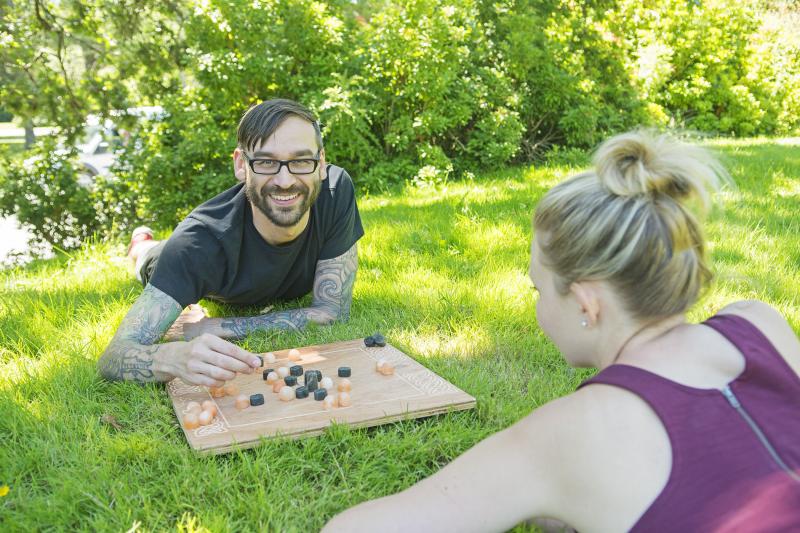Viking Age skill-building at the Royal BC Museum
- Anne MacLaurin

The new "Vikings: Lives beyond the Legend" exhibition at the Royal BC Museum is providing an opportunity for some UVic anthropology students to build their knowledge of Viking culture and share in community education at the same time. Jokes about these students' "cutting edge" skills will have to wait, though. While popular culture representations of the Vikings often put axes, raiding expeditions and pointy headgear first, the wealth of the Viking culture and their complex lifeworld was much more varied. And that's just what the anthropology students are helping community audiences appreciate.
For professor Erin McGuire, supporting the Royal BC Museum exhibition was a perfect opportunity to teach her Viking archaeology course (ANTH 398) outside of the classroom-while also creating room in the course for community members.
"Having community members as active participants in the course brought us new perspectives," said McGuire. "It was a chance for students to share ideas with others and hear other people's thoughts on the things we were reading and examining in the exhibition."
"I found it deeply enriching," said Joy Bagnall, who was one of six community members who attended the ANTH 398 classes held at museum. "Besides learning about the obvious historical and cultural aspects by lecture, which was of course extremely interesting, I also enjoyed engaging in Viking weaving, metal work and needle knitting-without the pressure of having to produce a final project like the students had to."
A natural synergy between UVic and the Royal BC Museum emerged, so when the museum needed more volunteer "craftsmen," McGuire recommended some of her fourth-year anthropology students.
Shawn Cur&e#180; was one of the four students hired as a craftsman for the Viking exhibition. He had taken Viking archaeology classes with McGuire and also worked as her research assistant, so she knew of his keen interest to be involved with the museum.
"In one of my medieval archaeology classes with Dr. McGuire, we were assigned to choose an experimental archaeology project," says Cur&e#180;, "I chose Hnefatafl-a board game played by Vikings."
"I like to use the example of board games for thinking about what we can learn about Vikings and ourselves," said McGuire. "I taught my students how to play a couple of Viking games and we used it as a starting off point for a conversation about games and social structures. Hnefatafl isn't actually fair. It's a two-player game but only one player gets a king. The king's side almost always wins."
Cur&e#180; and the two other members of his group crafted the Hnefatafl game pieces by hand out of alabaster and soap stone to show that it was labour intensive and that game pieces found in graves can suggest the status of the person buried there. They also built the board and learned how to play the game in class.
"When the Viking exhibition arrived, it seemed like my game would fit in nicely with the craftsman activity nights being held every Saturday at museum," explained Cur&e#180;. "I was really excited because I knew I could talk to visitors about these artifacts in a way that they might not get from simply seeing them in a case."
Cur&e#180; was hired by the Royal BC Museum along with fellow anthropology students Rose Pappas-Acreman, Amina Chergui and Bradley Clements to teach museum and community members some of the skills of the Viking Age. Chergui demonstrated nalbinding, a single needle-knitting technology practice in early medieval Scandinavia, and a skill she picked up in her Viking archaeology course at UVic.
"I enjoy how it exposes people in a very hands-on way to the extensive and laborious effort that is involved in clothing production," said Chergui. "It makes people think and understand how challenging it would have been in the Viking Age to clothe one's family."
Pappas-Acreman taught the art of bead making to community members, children and families. She also helped with activities during the Viking sleepover at the museum involving 100 children and parents.
Clements planned educational and fun family activities involving the ancient use of rune stones.
All four students' experiences, teaching skills from the Viking Age to community members, have enriched their appreciation of their coursework. And, at least for now, there's no word on whether Thunder the Mascot will be invited to the Royal BC Museum for future assistance at the exhibition.

